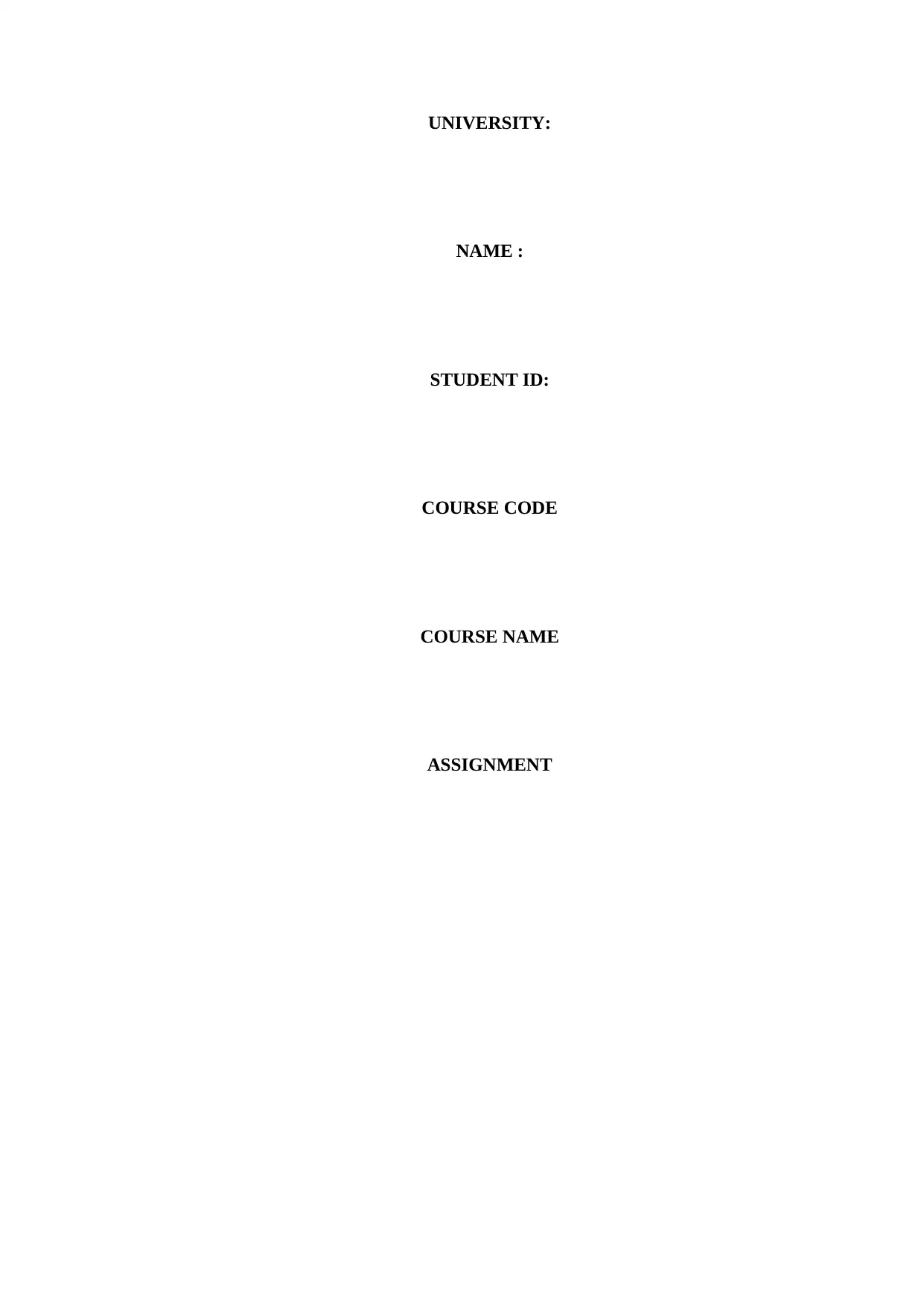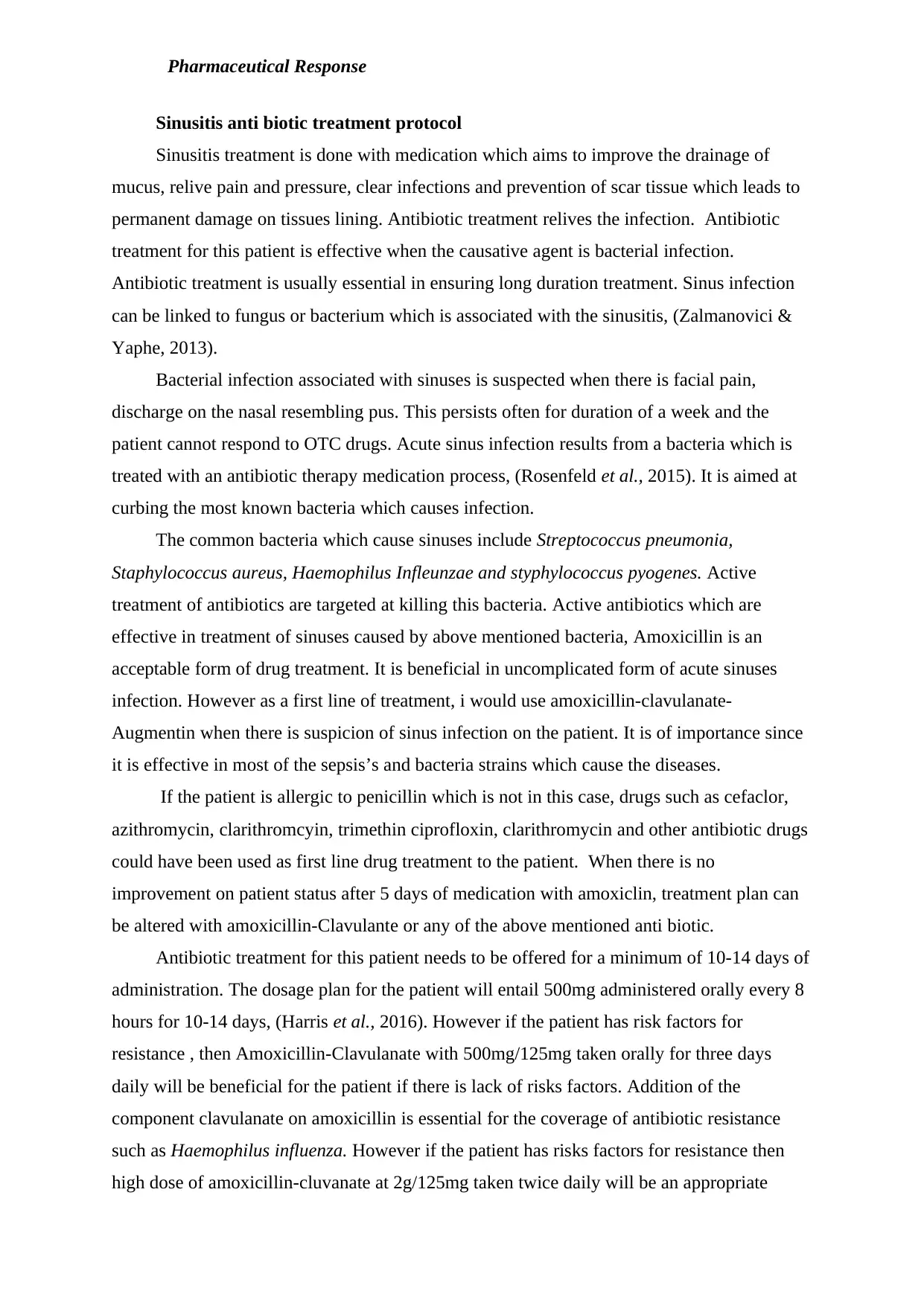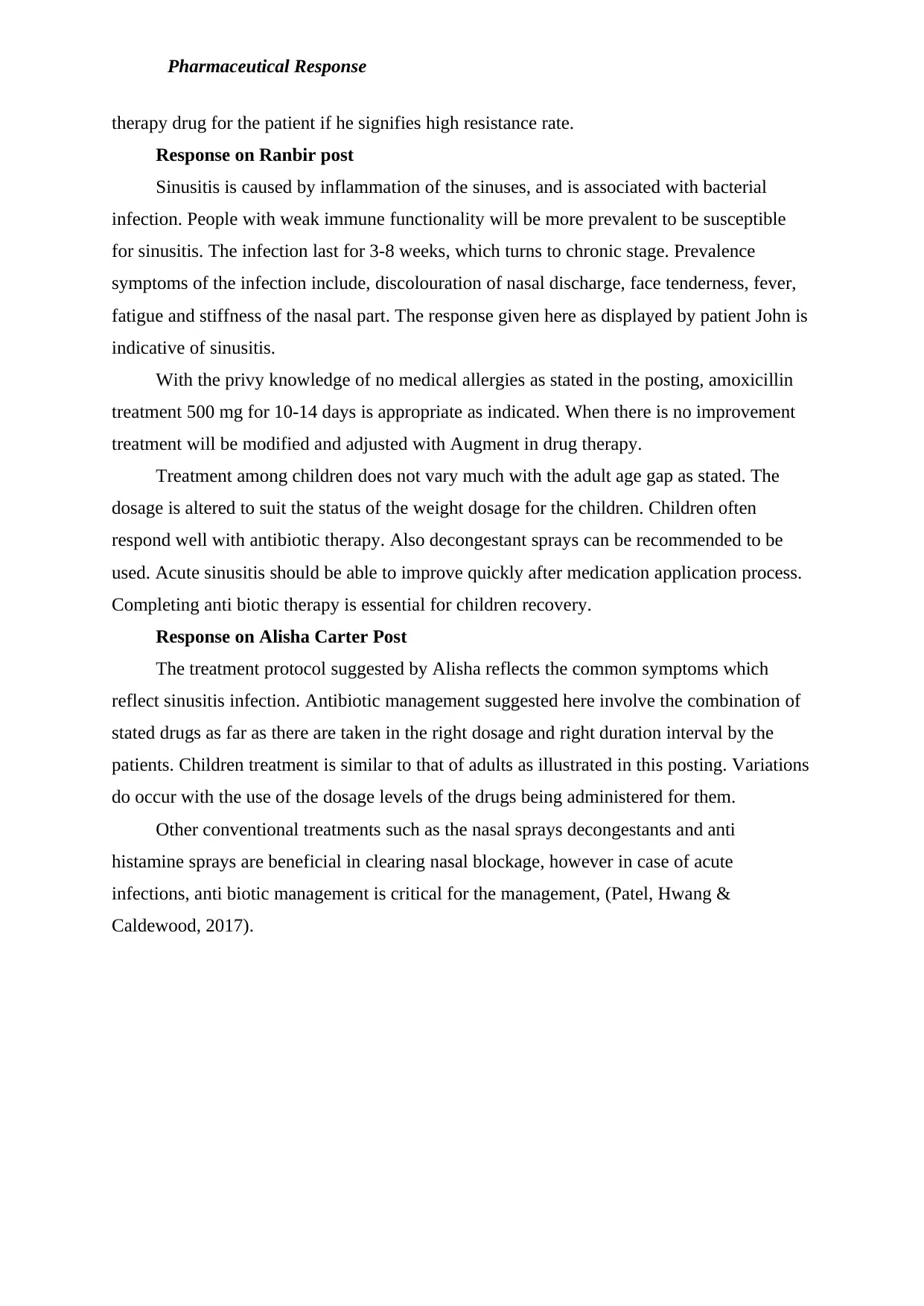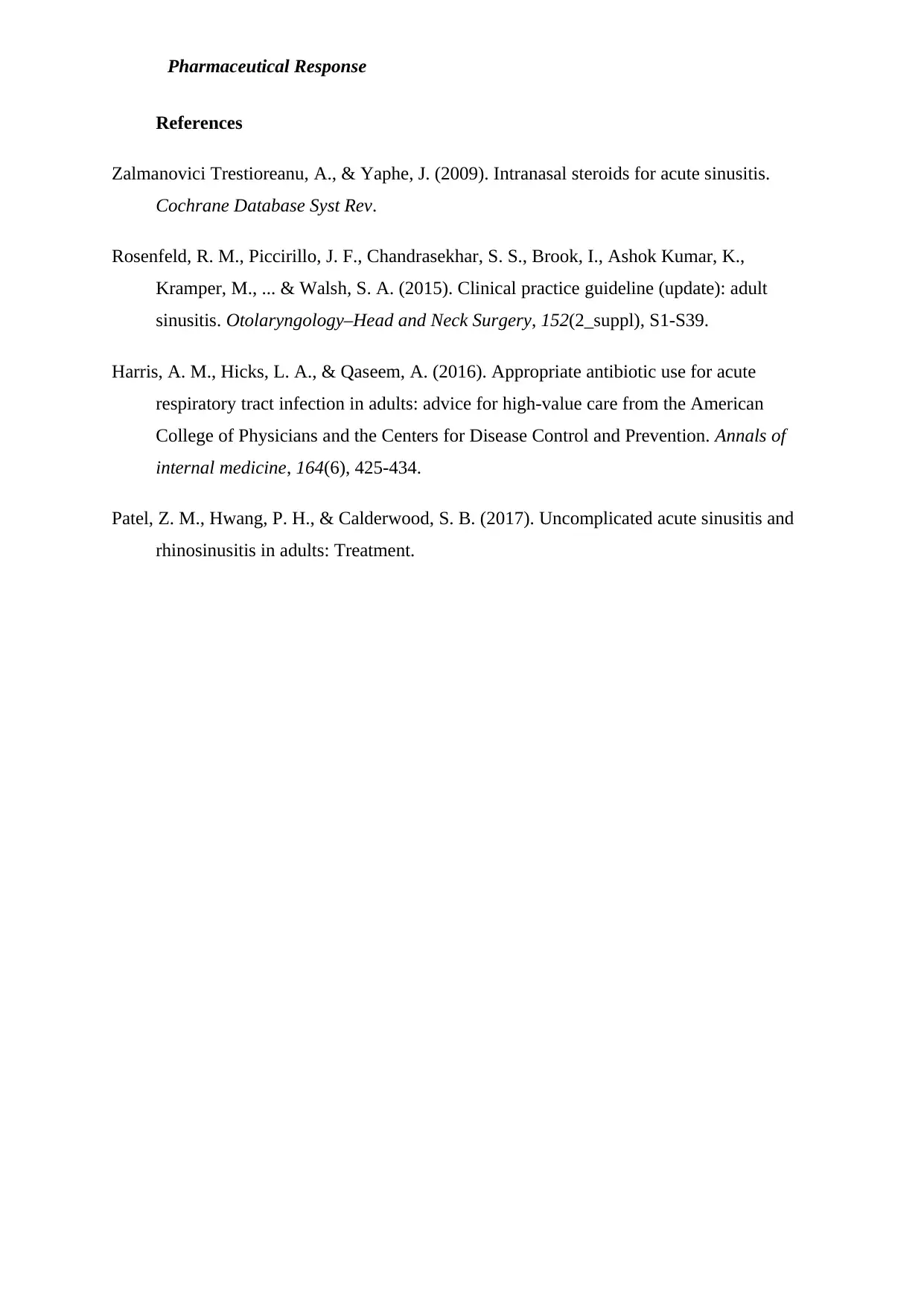Analyzing Pharmaceutical Response to Sinusitis: Antibiotic Protocols
VerifiedAdded on 2023/06/15
|4
|1017
|440
Report
AI Summary
This report provides a pharmaceutical response to sinusitis, focusing on antibiotic treatment protocols. It discusses the importance of antibiotic treatment in managing bacterial infections associated with sinusitis, highlighting common bacteria such as Streptococcus pneumonia, Staphylococcus aureus, and Haemophilus influenzae. The report suggests Amoxicillin-clavulanate (Augmentin) as a first-line treatment, especially when there is suspicion of sinus infection, and outlines alternative drugs for patients with penicillin allergies. It emphasizes the need for a minimum of 10-14 days of antibiotic administration, with specific dosage plans based on patient risk factors. The report also analyzes responses from other individuals, validating the use of amoxicillin and Augmentin in treating sinusitis, while also mentioning the importance of decongestant and antihistamine sprays in clearing nasal blockages. This assignment solution is available on Desklib, a platform offering a wide array of study resources for students.

UNIVERSITY:
NAME :
STUDENT ID:
COURSE CODE
COURSE NAME
ASSIGNMENT
NAME :
STUDENT ID:
COURSE CODE
COURSE NAME
ASSIGNMENT
Paraphrase This Document
Need a fresh take? Get an instant paraphrase of this document with our AI Paraphraser

Pharmaceutical Response
Sinusitis anti biotic treatment protocol
Sinusitis treatment is done with medication which aims to improve the drainage of
mucus, relive pain and pressure, clear infections and prevention of scar tissue which leads to
permanent damage on tissues lining. Antibiotic treatment relives the infection. Antibiotic
treatment for this patient is effective when the causative agent is bacterial infection.
Antibiotic treatment is usually essential in ensuring long duration treatment. Sinus infection
can be linked to fungus or bacterium which is associated with the sinusitis, (Zalmanovici &
Yaphe, 2013).
Bacterial infection associated with sinuses is suspected when there is facial pain,
discharge on the nasal resembling pus. This persists often for duration of a week and the
patient cannot respond to OTC drugs. Acute sinus infection results from a bacteria which is
treated with an antibiotic therapy medication process, (Rosenfeld et al., 2015). It is aimed at
curbing the most known bacteria which causes infection.
The common bacteria which cause sinuses include Streptococcus pneumonia,
Staphylococcus aureus, Haemophilus Infleunzae and styphylococcus pyogenes. Active
treatment of antibiotics are targeted at killing this bacteria. Active antibiotics which are
effective in treatment of sinuses caused by above mentioned bacteria, Amoxicillin is an
acceptable form of drug treatment. It is beneficial in uncomplicated form of acute sinuses
infection. However as a first line of treatment, i would use amoxicillin-clavulanate-
Augmentin when there is suspicion of sinus infection on the patient. It is of importance since
it is effective in most of the sepsis’s and bacteria strains which cause the diseases.
If the patient is allergic to penicillin which is not in this case, drugs such as cefaclor,
azithromycin, clarithromcyin, trimethin ciprofloxin, clarithromycin and other antibiotic drugs
could have been used as first line drug treatment to the patient. When there is no
improvement on patient status after 5 days of medication with amoxiclin, treatment plan can
be altered with amoxicillin-Clavulante or any of the above mentioned anti biotic.
Antibiotic treatment for this patient needs to be offered for a minimum of 10-14 days of
administration. The dosage plan for the patient will entail 500mg administered orally every 8
hours for 10-14 days, (Harris et al., 2016). However if the patient has risk factors for
resistance , then Amoxicillin-Clavulanate with 500mg/125mg taken orally for three days
daily will be beneficial for the patient if there is lack of risks factors. Addition of the
component clavulanate on amoxicillin is essential for the coverage of antibiotic resistance
such as Haemophilus influenza. However if the patient has risks factors for resistance then
high dose of amoxicillin-cluvanate at 2g/125mg taken twice daily will be an appropriate
Sinusitis anti biotic treatment protocol
Sinusitis treatment is done with medication which aims to improve the drainage of
mucus, relive pain and pressure, clear infections and prevention of scar tissue which leads to
permanent damage on tissues lining. Antibiotic treatment relives the infection. Antibiotic
treatment for this patient is effective when the causative agent is bacterial infection.
Antibiotic treatment is usually essential in ensuring long duration treatment. Sinus infection
can be linked to fungus or bacterium which is associated with the sinusitis, (Zalmanovici &
Yaphe, 2013).
Bacterial infection associated with sinuses is suspected when there is facial pain,
discharge on the nasal resembling pus. This persists often for duration of a week and the
patient cannot respond to OTC drugs. Acute sinus infection results from a bacteria which is
treated with an antibiotic therapy medication process, (Rosenfeld et al., 2015). It is aimed at
curbing the most known bacteria which causes infection.
The common bacteria which cause sinuses include Streptococcus pneumonia,
Staphylococcus aureus, Haemophilus Infleunzae and styphylococcus pyogenes. Active
treatment of antibiotics are targeted at killing this bacteria. Active antibiotics which are
effective in treatment of sinuses caused by above mentioned bacteria, Amoxicillin is an
acceptable form of drug treatment. It is beneficial in uncomplicated form of acute sinuses
infection. However as a first line of treatment, i would use amoxicillin-clavulanate-
Augmentin when there is suspicion of sinus infection on the patient. It is of importance since
it is effective in most of the sepsis’s and bacteria strains which cause the diseases.
If the patient is allergic to penicillin which is not in this case, drugs such as cefaclor,
azithromycin, clarithromcyin, trimethin ciprofloxin, clarithromycin and other antibiotic drugs
could have been used as first line drug treatment to the patient. When there is no
improvement on patient status after 5 days of medication with amoxiclin, treatment plan can
be altered with amoxicillin-Clavulante or any of the above mentioned anti biotic.
Antibiotic treatment for this patient needs to be offered for a minimum of 10-14 days of
administration. The dosage plan for the patient will entail 500mg administered orally every 8
hours for 10-14 days, (Harris et al., 2016). However if the patient has risk factors for
resistance , then Amoxicillin-Clavulanate with 500mg/125mg taken orally for three days
daily will be beneficial for the patient if there is lack of risks factors. Addition of the
component clavulanate on amoxicillin is essential for the coverage of antibiotic resistance
such as Haemophilus influenza. However if the patient has risks factors for resistance then
high dose of amoxicillin-cluvanate at 2g/125mg taken twice daily will be an appropriate

Pharmaceutical Response
therapy drug for the patient if he signifies high resistance rate.
Response on Ranbir post
Sinusitis is caused by inflammation of the sinuses, and is associated with bacterial
infection. People with weak immune functionality will be more prevalent to be susceptible
for sinusitis. The infection last for 3-8 weeks, which turns to chronic stage. Prevalence
symptoms of the infection include, discolouration of nasal discharge, face tenderness, fever,
fatigue and stiffness of the nasal part. The response given here as displayed by patient John is
indicative of sinusitis.
With the privy knowledge of no medical allergies as stated in the posting, amoxicillin
treatment 500 mg for 10-14 days is appropriate as indicated. When there is no improvement
treatment will be modified and adjusted with Augment in drug therapy.
Treatment among children does not vary much with the adult age gap as stated. The
dosage is altered to suit the status of the weight dosage for the children. Children often
respond well with antibiotic therapy. Also decongestant sprays can be recommended to be
used. Acute sinusitis should be able to improve quickly after medication application process.
Completing anti biotic therapy is essential for children recovery.
Response on Alisha Carter Post
The treatment protocol suggested by Alisha reflects the common symptoms which
reflect sinusitis infection. Antibiotic management suggested here involve the combination of
stated drugs as far as there are taken in the right dosage and right duration interval by the
patients. Children treatment is similar to that of adults as illustrated in this posting. Variations
do occur with the use of the dosage levels of the drugs being administered for them.
Other conventional treatments such as the nasal sprays decongestants and anti
histamine sprays are beneficial in clearing nasal blockage, however in case of acute
infections, anti biotic management is critical for the management, (Patel, Hwang &
Caldewood, 2017).
therapy drug for the patient if he signifies high resistance rate.
Response on Ranbir post
Sinusitis is caused by inflammation of the sinuses, and is associated with bacterial
infection. People with weak immune functionality will be more prevalent to be susceptible
for sinusitis. The infection last for 3-8 weeks, which turns to chronic stage. Prevalence
symptoms of the infection include, discolouration of nasal discharge, face tenderness, fever,
fatigue and stiffness of the nasal part. The response given here as displayed by patient John is
indicative of sinusitis.
With the privy knowledge of no medical allergies as stated in the posting, amoxicillin
treatment 500 mg for 10-14 days is appropriate as indicated. When there is no improvement
treatment will be modified and adjusted with Augment in drug therapy.
Treatment among children does not vary much with the adult age gap as stated. The
dosage is altered to suit the status of the weight dosage for the children. Children often
respond well with antibiotic therapy. Also decongestant sprays can be recommended to be
used. Acute sinusitis should be able to improve quickly after medication application process.
Completing anti biotic therapy is essential for children recovery.
Response on Alisha Carter Post
The treatment protocol suggested by Alisha reflects the common symptoms which
reflect sinusitis infection. Antibiotic management suggested here involve the combination of
stated drugs as far as there are taken in the right dosage and right duration interval by the
patients. Children treatment is similar to that of adults as illustrated in this posting. Variations
do occur with the use of the dosage levels of the drugs being administered for them.
Other conventional treatments such as the nasal sprays decongestants and anti
histamine sprays are beneficial in clearing nasal blockage, however in case of acute
infections, anti biotic management is critical for the management, (Patel, Hwang &
Caldewood, 2017).
⊘ This is a preview!⊘
Do you want full access?
Subscribe today to unlock all pages.

Trusted by 1+ million students worldwide

Pharmaceutical Response
References
Zalmanovici Trestioreanu, A., & Yaphe, J. (2009). Intranasal steroids for acute sinusitis.
Cochrane Database Syst Rev.
Rosenfeld, R. M., Piccirillo, J. F., Chandrasekhar, S. S., Brook, I., Ashok Kumar, K.,
Kramper, M., ... & Walsh, S. A. (2015). Clinical practice guideline (update): adult
sinusitis. Otolaryngology–Head and Neck Surgery, 152(2_suppl), S1-S39.
Harris, A. M., Hicks, L. A., & Qaseem, A. (2016). Appropriate antibiotic use for acute
respiratory tract infection in adults: advice for high-value care from the American
College of Physicians and the Centers for Disease Control and Prevention. Annals of
internal medicine, 164(6), 425-434.
Patel, Z. M., Hwang, P. H., & Calderwood, S. B. (2017). Uncomplicated acute sinusitis and
rhinosinusitis in adults: Treatment.
References
Zalmanovici Trestioreanu, A., & Yaphe, J. (2009). Intranasal steroids for acute sinusitis.
Cochrane Database Syst Rev.
Rosenfeld, R. M., Piccirillo, J. F., Chandrasekhar, S. S., Brook, I., Ashok Kumar, K.,
Kramper, M., ... & Walsh, S. A. (2015). Clinical practice guideline (update): adult
sinusitis. Otolaryngology–Head and Neck Surgery, 152(2_suppl), S1-S39.
Harris, A. M., Hicks, L. A., & Qaseem, A. (2016). Appropriate antibiotic use for acute
respiratory tract infection in adults: advice for high-value care from the American
College of Physicians and the Centers for Disease Control and Prevention. Annals of
internal medicine, 164(6), 425-434.
Patel, Z. M., Hwang, P. H., & Calderwood, S. B. (2017). Uncomplicated acute sinusitis and
rhinosinusitis in adults: Treatment.
1 out of 4
Related Documents
Your All-in-One AI-Powered Toolkit for Academic Success.
+13062052269
info@desklib.com
Available 24*7 on WhatsApp / Email
![[object Object]](/_next/static/media/star-bottom.7253800d.svg)
Unlock your academic potential
Copyright © 2020–2025 A2Z Services. All Rights Reserved. Developed and managed by ZUCOL.





